
The Gallipoli peninsula is located in the southern part of East Thrace, the European part of Turkey, with the Aegean Sea to the west and the Dardanelles strait to the east.

The Gallipoli campaign, the Dardanelles campaign, the Defense of Gallipoli or the Battle of Gallipoli was a military campaign in the First World War on the Gallipoli peninsula from 19 February 1915 to 9 January 1916. The Entente powers, Britain, France and the Russian Empire, sought to weaken the Ottoman Empire, one of the Central Powers, by taking control of the Ottoman straits. This would expose the Ottoman capital at Constantinople to bombardment by Entente battleships and cut it off from the Asian part of the empire. With Turkey defeated, the Suez Canal would be safe and a year-round Entente supply route could be opened through the Black Sea to warm-water ports in Russia.

The Battle of the Nek was a minor battle that took place on 7 August 1915, during the Gallipoli campaign of World War I. "The Nek" was a narrow stretch of ridge on the Gallipoli Peninsula. The name derives from the Afrikaans word for a "mountain pass" but the terrain itself was a perfect bottleneck and easy to defend, as had been proven during an Ottoman attack in June. It connected Australian and New Zealand trenches on the ridge known as "Russell's Top" to the knoll called "Baby 700" on which the Ottoman defenders were entrenched.

The Battle of Lone Pine was fought between Australian and New Zealand Army Corps (ANZAC) and Ottoman Empire forces during the Gallipoli Campaign of the First World War, between 6 and 10 August 1915. The battle was part of a diversionary attack to draw Ottoman attention away from the main assaults being conducted by British, Indian and New Zealand troops around Sari Bair, Chunuk Bair and Hill 971, which became known as the August Offensive.

The Battle of Chunuk Bair was a World War I battle fought between the Ottoman defenders and troops of the British Empire over control of the peak in August 1915. The capture of Chunuk Bair,, the secondary peak of the Sari Bair range, was one of the two objectives of the Battle of Sari Bair.
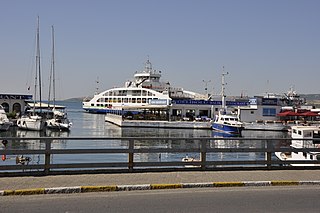
Gelibolu, also known as Gallipoli, is the name of a town in Çanakkale Province of the Marmara Region, located in Eastern Thrace in the European part of Turkey on the southern shore of the peninsula named after it on the Dardanelles strait, 3 kilometres (1.9 mi) away from Lapseki on the other shore. It is the seat of Gelibolu District. Its population is 31,782 (2021).
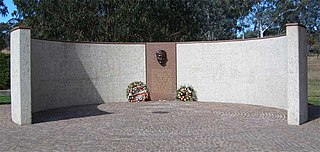
The Kemal Atatürk Memorial is a memorial directly opposite the Australian War Memorial on Anzac Parade, the principal memorial and ceremonial parade in Canberra, the capital of Australia.

Mehmet Tekin Arıburun was a Turkish soldier and statesman. He was born in then-Ottoman territory of Ishtib, Kosovo Vilayet. He was the last (Acting) President to be born outside the territory of present-day Turkey.
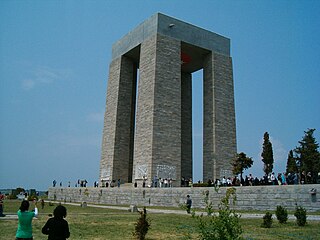
The Çanakkale Martyrs' Memorial is a war memorial commemorating the service of about 253,000 Turkish soldiers who participated at the Battle of Gallipoli, which took place from April 1915 to December 1915 during the First World War. It is located within the Gallipoli Peninsula Historical National Park on Hisarlık Hill in Morto Bay at the southern end of the Gallipoli peninsula in Çanakkale Province, Turkey.
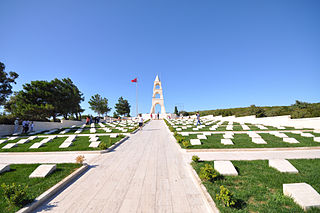
The 57th Infantry Regiment or simply 57th Regiment was a regiment of the Ottoman Army during World War I. In response to the landing at Anzac Cove of Australian and New Zealand forces on 25 April 1915 the 57th Regiment counterattacked, slowed the Allied advance and lost about half of its personnel. Mustafa Kemal later noted that the 57th Regiment was "a famous regiment this, because it was completely wiped out".

Hüseyin Avni Bey was the commander of the 57th Infantry Regiment of the Ottoman Army at the Battle of Gallipoli during which he led a counterattack that successfully stabilized the right flank of the Turkish defences on the 25 April 1915.
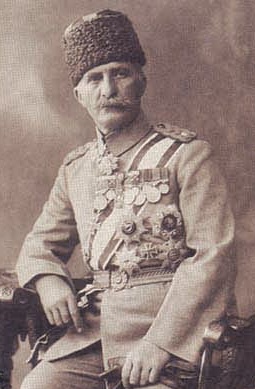
Esat Pasha Janina, known as Mehmed Esad Bülkat after the 1934 Surname Law, was an Ottoman general during the First Balkan War, where he led the Yanya Corps, and in World War I, where he was the senior Ottoman commander in the Gallipoli campaign.

Mehmed Şefik known as Mehmet Şefik Aker after the 1934 Surname Law, was an officer of the Ottoman Army and the Turkish Army. He is best known for his service during the Gallipoli campaign and in particular the defense he led during the first day of the Allied landing on 25 April 1915. He subsequently served in a number of senior roles during the rest of World War I and during the War of Independence.
The 19th Infantry Division was a formation of the Ottoman Army, during the Balkan Wars and the First World War. Two thirds of the division was made up of Syrian Arabs, who faced the first wave of the Allied invasion during the Gallipoli campaign, and one third were Turks.
The 9th Infantry Division was a formation of the Ottoman Turkish Army, during the Balkan Wars, and the First World War.

The Battle of Kumkale was a World War I battle fought between Ottoman and French forces. It was a part of the Gallipoli Campaign fought on the Anatolian (Asian) part of the Dardanelles Strait as a diversion from the main landings on the Gallipoli peninsula. Kumkale is the name of a village which now is a part of Troy national park.
Gelibolu War Museum is a museum in Gelibolu, Turkey.

The Gallipoli Peninsula Historical Site covers over 33,000 hectares in Gallipoli, Turkey. The park was established in 1973 by the Turkish government and is included in the United Nations list of National Parks and Protected Areas. Gallipoli Peninsula Historical Site is home to memorials, graveyards, and commemorations of events that took place on the peninsula since the First World War.

The 27th Infantry Regiment or simply 27th Regiment was a regiment of the Ottoman Army during World War I. It is best known for its response to the landing at Anzac Cove of Australian and New Zealand forces on 25 April 1915 during the Gallipoli campaign.


















